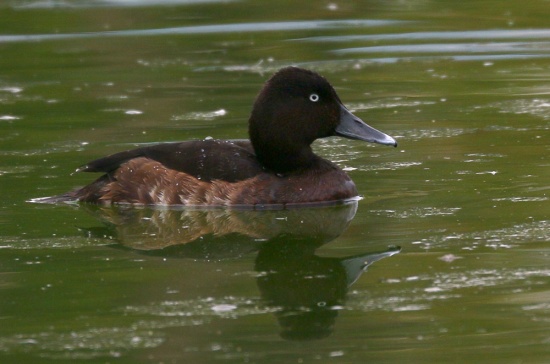Sbarnhardt (talk | contribs) (Amend Gsearch to current format, Add Gsearch template) |
|||
| (4 intermediate revisions by 3 users not shown) | |||
| Line 1: | Line 1: | ||
| − | [[Image: | + | [[Image:151107112 Suminoekoen.jpg|thumb|550px|right|Photo by {{user|MacNara|MacNara}}<br /> Suminoe Park, Osaka, [[Japan]], November 2015]] |
;[[:Category:Aythya|Aythya]] baeri | ;[[:Category:Aythya|Aythya]] baeri | ||
| − | |||
==Identification== | ==Identification== | ||
| − | + | 41–47 cm (16-18 in)<br /> | |
| − | + | *Dark back and upper flanks | |
| + | *White belly | ||
| + | *Blackish head, upper neck | ||
| + | *Chestnut-brown and white flanks | ||
| + | *White wing bar visible in flight | ||
| + | *Whitish eyes | ||
==Distribution== | ==Distribution== | ||
| − | + | [[Asia]]: found in [[Russia]], [[Siberia]], [[China]], [[Inner Mongolia]], [[Pakistan]], [[India]], Eastern and Western [[Himalayas]], [[Bangladesh]], [[North Korea]], [[Japan]], [[Taiwan]]<br /> | |
| − | + | '''Southeast Asia''': [[Indochina]], [[Myanmar]], [[Vietnam]], [[Thailand]] | |
==Taxonomy== | ==Taxonomy== | ||
| − | + | This is a [[Dictionary_M-S#M|monotypic]] species<sup>[[#References|[1]]]</sup>. | |
| − | |||
==Habitat== | ==Habitat== | ||
| − | + | Found on lakes with rich aquatic vegetation. Also in nearby dense grassland and flooded meadows. In winter usually seen on freshwater lakes, rivers and sometimes reservoirs. | |
| − | |||
==Behaviour== | ==Behaviour== | ||
| + | ====Diet==== | ||
| + | There is very little recorded, but they are thought to eat plant materials, particularly rice, and frogs. | ||
| + | ====Breeding==== | ||
The nest is built on a tussock or under shrubs, sometimes floating, and occasionally amongst branches. | The nest is built on a tussock or under shrubs, sometimes floating, and occasionally amongst branches. | ||
| − | |||
==References== | ==References== | ||
| − | BirdLife International | + | #{{Ref-Clements6thAug15}}#Avibase |
| − | + | #BirdLife International | |
| + | #Handbook of the Birds of the World Alive (retrieved November 2015) | ||
| + | #Wikipedia | ||
| + | #BF Member observations | ||
| + | {{ref}} | ||
==External Links== | ==External Links== | ||
| − | {{GSearch| | + | {{GSearch|"Baer's Pochard"}} |
| − | + | {{GS-checked}} | |
[[Category:Birds]][[Category:Aythya]] | [[Category:Birds]][[Category:Aythya]] | ||
Latest revision as of 13:43, 26 November 2021
- Aythya baeri
Identification
41–47 cm (16-18 in)
- Dark back and upper flanks
- White belly
- Blackish head, upper neck
- Chestnut-brown and white flanks
- White wing bar visible in flight
- Whitish eyes
Distribution
Asia: found in Russia, Siberia, China, Inner Mongolia, Pakistan, India, Eastern and Western Himalayas, Bangladesh, North Korea, Japan, Taiwan
Southeast Asia: Indochina, Myanmar, Vietnam, Thailand
Taxonomy
This is a monotypic species[1].
Habitat
Found on lakes with rich aquatic vegetation. Also in nearby dense grassland and flooded meadows. In winter usually seen on freshwater lakes, rivers and sometimes reservoirs.
Behaviour
Diet
There is very little recorded, but they are thought to eat plant materials, particularly rice, and frogs.
Breeding
The nest is built on a tussock or under shrubs, sometimes floating, and occasionally amongst branches.
References
- Clements, J. F., T. S. Schulenberg, M. J. Iliff, D. Roberson, T. A. Fredericks, B. L. Sullivan, and C. L. Wood. 2015. The eBird/Clements checklist of birds of the world: v2015, with updates to August 2015. Downloaded from http://www.birds.cornell.edu/clementschecklist/download/
- Avibase
- BirdLife International
- Handbook of the Birds of the World Alive (retrieved November 2015)
- Wikipedia
- BF Member observations
Recommended Citation
- BirdForum Opus contributors. (2024) Baer's Pochard. In: BirdForum, the forum for wild birds and birding. Retrieved 19 May 2024 from https://www.birdforum.net/opus/Baer%27s_Pochard
External Links
GSearch checked for 2020 platform.




